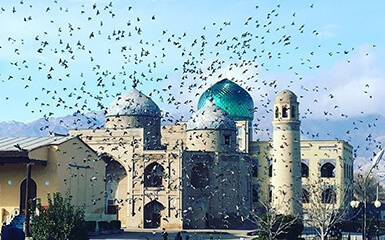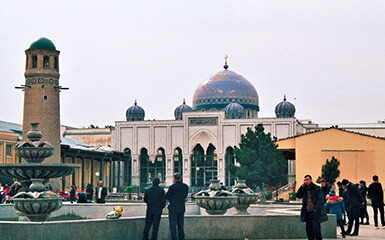Kok Gumbaz
Ajina Teppa
Ancient Panjakent
Anzob Tunnel
Beshkent Qala
Childukhtaron
Khazrati Shokh
Mug Teppa
Gharm Chashma
Hisor Historical
Haji Yaqub mosque
Hazrati-Bobo complex
Lake Iskanderkul
Kalai-Khumb
Karatag
Karon
Khishtin caravanserai
Khorog
Khulbuk
Lake Karakul
Abdullatif Sultan
Madrasai Kuhna
Abu Abdullah Rudaki
Khoja Mashhad
Khudoyor Valami
Makhmudi Azam
Mir Sayyid Ali Hamadani
Muhammed Bashoro
Sheikh Muslihiddin
Nurek Mountain Lake
Pamir
Sarazm
Sari-Khosor
Seven Lakes
Shirkent
Chiluchorchashma
Takht-i Sangin
Mausoleum of Sheikh Muslihiddin

One of the main attractions of the historical centre of ancient Khujand is the ancient mausoleum of Sheikh Muslihiddin – poet and ruler. Despite numerous destructions and reconstructions, the mausoleum is still a harmonious complex and gives an insight into the medieval architecture of the city. The tomb is named after Sheikh Muslihiddin or Maslihaddin Khujandi, the medieval ruler of Khujand, who lived in the XII century. The Sheikh was an extraordinary person, as befits an ancient Eastern ruler - in addition to public relations; he was also engaged in poetry. His autobiography to his descendants is called “Menaqib”. He was originally buried in the village of Unji, but later his admirers carried the ruler's ashes to Khujand and erected a shrine over the tomb. The tomb of the XII century did not differ excessively in size and was a burial chamber made of baked brick, decorated with terracotta plates. Already in the XIII century, during the occupation of Genghis Khan, and the mausoleum was almost destroyed.
In the 14th century the mausoleum was rebuilt but with a different design and now consists of two rooms. However, it was later destroyed again for unknown reasons. In the 16th century, a new structure was built on the ruins of the old tomb, quite different from the previous one in terms of structure and plan. It ceased to be just a shrine and turned into a shrine-khonako, that is, a building for prayer and ritual ceremonies.
Sheikh Muslihiddin Tomb is located in the northwest of Panjshanbe Square. The tomb is next to the Friday mosque. The entrance to the tomb is through two embossed wooden doors on the south façade of the building. On the doors, there is a plaque with the name of Sheikh Muslihiddin and the years of his life, namely 1133-1223.
This complex consists of a cathedral mosque, a minaret over 20 meters high built in the late 19th century and ancient burial sites, including the mausoleum of Sheikh Muslihiddin in the centre. The mausoleum itself is a two-story domed skylight structure with a central cross-shaped zyoratkhona (remembrance hall) and domical gurkhona (tomb-vault). At the centre of the structure is a carved wooden tombstone (sagona), covered with a fine, geometric carving filled with ornaments and inlaid gemstones.

